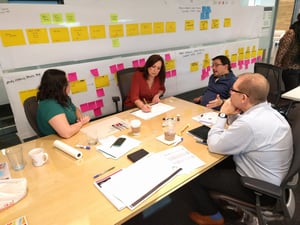When I joined Array in 2013, our accounting team handled new hire paperwork and general orientation during each employee’s first day. Within my first three months, hiring began to pick up as the firm emerged from the recession. We quickly realized that we needed to enhance our onboarding process. I began to develop ways to make orientation more comprehensive and engaging, and the evolution of the onboarding process had begun. Little did I know how it would grow over the next several years.
As the process developed, and we built our staff from 90 to over 130, I found myself teaching new employees how to use a myriad of platforms on the first few days of orientation. This “deep dive” was not position-specific and wasn’t informed by the nuances of how an interior designer may use a program differently or more frequently than a graphic designer, or vice versa. This was information that I could not provide. For the new hire, it was a fire-hose of information that was too much to retain. Our new staff members were not getting what they needed to be successful.
 Meanwhile, Array was taking a big step in our continuous improvement efforts by engaging an expert to lead value stream mapping for the entire firm. Eighteen process improvement initiatives were identified and prioritized, our onboarding process included. A cross-functional team was chosen to investigate the current state of our orientation process, identify the ideal future state and come to consensus on a specific roadmap of improvement initiatives. This Opportunity for Improvement was mine to own.
Meanwhile, Array was taking a big step in our continuous improvement efforts by engaging an expert to lead value stream mapping for the entire firm. Eighteen process improvement initiatives were identified and prioritized, our onboarding process included. A cross-functional team was chosen to investigate the current state of our orientation process, identify the ideal future state and come to consensus on a specific roadmap of improvement initiatives. This Opportunity for Improvement was mine to own.
Our process improvement exercises revealed a failure to introduce the new employee to their team and manager right from the start. Participation in orientation and onboarding was needed by the direct manager, senior leadership, and their teams to integrate the new staff person into their role. Human Resources was covering far too much material on days one and two to keep new hires busy and help them feel engaged. I filled their first few days with drawn-out tours of platforms that they would not touch for several weeks or months. No matter how much I reviewed, they did not understand the relevance and were not feeling connected.
Today’s onboarding begins weeks before a new employee steps foot in the office. Their first few days are outlined in a new hire email shortly after the offer is signed. A “new hire buddy” is identified, and they communicate with the new hire before their first day to provide a second resource for non-HR questions. New hire orientation on day one is now cut down to just 90 minutes, providing the necessary timesheet, health insurance and workstation orientation. We cover just the basics for payroll and show how to make time-sensitive benefits elections. Managers organize a welcome lunch for the employee, followed by a meeting with their manager to review role expectations and project needs. Allowing a new hire to get comfortable at their own desk and with those seated in their immediate vicinity has much more worth than sitting at my elbow for hours on end trying to absorb everything in a couple of days. Through our new process, program orientation happens organically over the first few weeks or months based on the employee’s exposure to and use of our platforms and programs.
One new onboarding initiative that has been particularly well-received is our “new hire buddy program.”  The buddy program pairs a seasoned employee with each new hire, many times from different departments. This diversity allows our new hires the opportunity to meet someone they may not typically cross paths with early in their time with Array. In addition to the new buddies going to lunch together on the new hire’s second day, our new staffers have a resource beside their manager or HR to whom they can ask questions about the day-to-day workings of the firm. A second recent initiative is to hold a performance management meeting on day one with their manager. During the meeting, they establish goals, review expectations, and gain an appreciation of our firm and bonus structure. By becoming well-informed from the onset of their Array career, our staff have more control over their advancement than ever before.
The buddy program pairs a seasoned employee with each new hire, many times from different departments. This diversity allows our new hires the opportunity to meet someone they may not typically cross paths with early in their time with Array. In addition to the new buddies going to lunch together on the new hire’s second day, our new staffers have a resource beside their manager or HR to whom they can ask questions about the day-to-day workings of the firm. A second recent initiative is to hold a performance management meeting on day one with their manager. During the meeting, they establish goals, review expectations, and gain an appreciation of our firm and bonus structure. By becoming well-informed from the onset of their Array career, our staff have more control over their advancement than ever before.
The final piece of the Array onboarding process takes place 30-60 days after new hires join the firm. We conduct a group training session several weeks after new hires have settled in, providing the opportunity for all of them to meet each other and leaders from different firm perspectives. During a noon-to-noon event at our corporate office, all new hires are greeted by our CEO Carl Davis, who introduces our integrated brand approach. They also meet with senior leadership from business development, marketing, continuous improvement and other key departments. We introduced this last piece of the onboarding process in 2017 and have since conducted eight new hire training sessions. Post session survey results from attendees are remarkable. Results show that new hires feel that they have a clear understanding of the expectations of their role, know where to find needed resources, and feel prepared to make use of the many tools and platforms at Array. The survey has demonstration nearly 100 percent participation in all aspects of the onboarding process.
But it doesn’t stop there. A step vital to our continuous improvement process is PDSA. Through the surveys, we gain insight into what attendees feel works well and what can be improved. In 2018 alone, we have implemented three improvements:
- Adding our CEO-led integrated brand intro
- Adding a corporate ambassador to arrange a group dinnerwith a few staff to join the new hires
- Changing some in-person presentations to video presentations that are circulated to our new hires once per week between their hire date and new hire training day
Our onboarding process now provides new hires with a full complement of HR, manager and cross-departmental training at a pace that is easier to absorb, process and put into action. As Array continues to grow, and we continue to refine our approach to welcoming new staff, the PDSA process will keep our training relevant across our brands.

